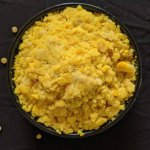Techniques – #K for Key Building Blocks






The Key building blocks concept or modular cooking concept is used to translate one recipe into multiple cuisines. Vegetables/ meats/ seafood & starches are common to all cuisines. Only the spices/ additives and cooking technique varies. All OPOS recipes are designed so that the core building blocks can be varied, giving rise to a multitude of recipes across cuisines, from a core theme. The Replace/ Supplement section in each OPOS recipe is designed to encourage modular cooking.
The idea of using modules or building blocks exist in every field. In home design, you set up a modular kitchen or bedroom by just invoking prebuilt units. In software, you have a set of subroutines you can invoke to do often repeated steps. In OPOS, we build complex recipes from ground up, across cuisines, by just using the appropriate modules. Just one module can change the parentage of the recipe. We can easily jump cuisines or create new fusion cuisines by just adding/ deleting modules.
Let’s take an example:
Layer 1: 2Tbsp water
Layer 2: 2C chopped vegetables
Layer 3: 1/4tsp each (salt, pepper)
Cook on high for 2 whistles. Release pressure. Mix all.
This is an universal recipe. It can fit into any cuisine. It can be served to anyone on Earth. Now let’s add a flavouring module as layer 4, say 1/2tsp (Garam masala/ Bengali panch foran/ Marathi Goda masala/ Tamil Sambar powder). You can now see the recipe jumping cuisines. By adding more modules, you can convert the same recipe into a full meal / stew / soup /dessert from any cuisine. Each layer can be a simple ingredient or a complex module.
Themes are universal. Each cuisine interprets these universal themes with its favourite ingredients and cooking techniques, to generate its own recipes.
Three cereals (rice, wheat & maize), a handful of vegetables, meats, herbs, spices & half a dozen cooking techniques – that’s all it takes to cook the bulk of World’s cuisines. We need to understand these key building blocks and the way they come together, gradually evolving into a cuisine. We can then move beyond recipes/ cuisines, liberating ourselves from the tyranny of ritualistic cooking and fixed combinations dictated by cultural conditioning.
Let us take a look at the key building blocks of world cuisine.
Starch: Wheat, rice and maize are the world’s primary source of starch. They form 90% of the world’s grain production. Most regional cuisines are built on these cereals. Some cuisines are based on non grain starches like Sago (Indonesia, Malaysia), Potato (Ireland, Latin America) & Cassava (Africa). Other minor starches, millets (Africa, rural India) & pseudo cereals are also consumed in pockets.
Protein: Ever since we learned to farm, we have mostly depended on plant protein (peas, beans & lentils). We supplement it with animal protein (Dairy, meat, seafood, eggs). A starch & protein combination exists in almost all cultures as they complement each other.
Fat: Animal fats dominated world cuisine till a few decades back as they were cheap and easy to extract. Easily extracted plant oils (sesame, olive, coconut) were the first oils pressed. All cuisines prefer fats easily available to it.
Micronutrients: A huge variety of fresh fruits, nuts, vegetables and edible greens supply most of our fiber & micronutrient requirements. Each region uses easily available fruits and vegetables in its cuisine.
Flavouring: A variety of herbs and spices are used across the world as flavouring. Some regions use fermented / cooked/ brewed flavourings (soy sauce, fish sauce etc)
Global Themes:
Almost all world cuisines convert the above ingredients into soups, salads, stews, dips, drinks and desserts in their daily meal. Each of these is a major theme and further get split into many minor themes. By using the key building blocks approach, we can easily translate themes from one cuisine into another cuisine. When chefs say only certain combinations of foods work ‘best’, they actually mean each region has evolved combinations based on their availability and their favourite cooking technique. The ‘availability’ changes over time and cuisines change to include new ingredients and cooking techniques. Even strong taboos change over time. Each cuisine is constantly evolving, but as the time frames are too large, chefs often speak of ‘purity’, ‘authenticity’ and ‘tradition’. They all change over time and you can safely bypass them, if you can understand the key building blocks of each cuisine and the factors that shape all cuisines – Availability, External Influences & Taboos.
Availability: Any cuisine develops around food and fuel available in a region. Fertile lands use a lot of fresh vegetables, herbs & dairy. Wintry/ desert regions rely on preserved food. Coastal regions emphasize seafood. Landlocked regions prefer freshwater fish. Where fuel was scarce, economical techniques (steaming, stir frying) evolved. Where fuel was plenty, baking/ grilling/ roasting became common.
External influences: When cultures meet, their cuisines change over time. Occasionally, a new cuisine is born. Tomatoes, chili, potatoes & maize came to be used in all cuisines after the Spanish took them out of the New world. Mass migration usually results in a new cuisine. New recipes appear almost immediately, but a new cuisine takes longer to evolve. With the world becoming a global village, all traditional cuisines are now morphing before our very eyes.
Taboos: Each region has its own set of cultural & religious taboos, around which its cuisine evolves. Jews/Muslims forbid pork, shellfish, amphibians & reptiles. Hindus ban beef, Jains prohibit root vegetables. Some foods are prohibited during certain times of the year. Meat during Lent (Christians), fresh vegetables/ greens during monsoons (Jains), cereals during religious fasts (Hindus). The Western world frowns on eating dogs/ cats/ rats /insects/ reptiles. Some African & Red Indian tribes sneer at fish eaters. Organ meats/ blood are shunned in US, Australia & Canada. Till today, orthodox temple cuisines in India avoid using chilies or tomatoes as they are not native to India.
Looked at this way, it is easy to identify the common thread across cuisines. Gaping holes and ingenious inventions in each cuisine become visible. (For example, The East never learned to bake or make cheese/ wines. The West never mastered spices, steaming, unleavened breads & the art of pickling). It is easy to see that there are no ‘rich’ or ‘poor’ cuisines. We can see human ingenuity manifest itself across cuisines, aboriginal or royal.
We can see how cuisines are alive and change all the time, and how the concept of ‘pure’ or authentic’ recipes changes with place and time. We see that no cuisine is perfect and how all cuisines have much to learn from each other.
The Key building blocks approach lets us transcend cuisines, freely using themes from one cuisine, ingredients from another and cooking techniques from a third, creating a variety of fusion dishes, which belong to no cuisine, but to all of them.
Understand the Key Building Blocks of global cuisine. Food cooked using these building blocks can be served to almost anyone across the world. Use these to translate any given recipe into its global/ national/ regional version by just replacing/ supplementing key building blocks
Global building blocks:
Starch: Rice, wheat, Maize, Potato
Protein: Dairy, legumes, beef, pork, chicken, goat, seafood, eggs
Fat: Animal fats / vegetable oils
Micronutrients ( Vegetables): Tomato, onion, eggplant, beans, cucumber, cabbage, carrots
Micronutrients ( Fruits) : Banana, apple, orange, mango
Flavouring: Onion, garlic, pepper, cumin, mint, paprika, cinnamon,
